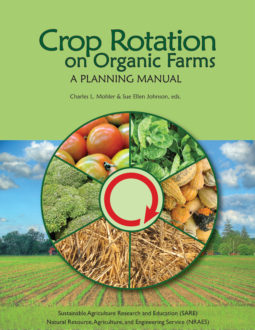Effective crop rotations are a foundation of organic cropping systems. Organic farmers recognize that crop rotation is necessary to maintain field productivity. Expert farmers design their rotations to (1) earn income and (2) increase soil quality or build “soil capital” (sidebar 2.1). Crop rotation and a crop rotation plan and records are required for organic certification of a field or farm.
Numerous books and articles outline the goals and benefits of crop rotations (see sidebar 2.2). The contribution of our panel of expert farmers is interesting in (1) the emphasis they give to business management decisions in crop rotation planning; and (2) the flexibility of their crop rotations, specifically the absence of fixed, long-term crop rotations. Their rotation planning is an ongoing annual process that incorporates information and objectives for multiple years. Many expert farmers do not have standardized, cyclical crop rotations for every field, yet our experts share an overall approach to designing, implementing, and adapting crop sequences on their farms. The tools in chapter 5 are designed to help readers develop their own expertise.
The Concepts of Soil Quality, Soil Capital, Soil Health, and Soil Life
The expert farmers used many terms interchangeably as they discussed rotations and their farm goals. Organic agriculture revolves around the concepts of soil life and soil biology. Organic practices, including crop rotation, are expected to enhance soil life and soil health. A basic tenet of organic agriculture is that biological diversity and soil organic matter are drivers of productive organic farming systems. Farmers believe that a soil high in organic matter leads to a healthy, biologically active soil that will have fewer crop fertility, pest, and disease problems. Farmers also use the term soil capital to express how soil building practices are an investment in long-term soil productivity.
What Some Good Books Say about Crop Rotation
Numerous books and articles do an excellent job of outlining rotation theory, guidelines, and practice. Many present crop-by-crop rotations. These may or may not reflect the real complexity of modern organic farming operations and successful farm management, but a sampling of the advice is listed below.
From Cyclopedia of American Agriculture (1907; L. H. Bailey, ed.), chapter 5, “Crop Management,” pp. 85–88:
- The rotation must adapt itself to the farmers business.
- It must adapt itself to the soil and fertility problem.
- The fertilizer question often modifies the rotation.
- The kind of soil and the climate may dictate the rotation.
- The labor supply has an important bearing on the character of the rotation course.
- The size of the farm and whether land can be used for pasturage are also determinants.
- The rotation must be planned with reference to the species of plants that will best serve one another, or produce the best interrelationship possible.
- The rotation must consider in what condition one crop will leave the soil for the succeeding crop, and how one crop can be seeded with another crop.
From Organic Farming (1990; Nicolas Lampkin), chapter 5, “Rotation Design for Organic Systems,” pp. 131–32:
“Usually a rotation contains at least one ‘money crop’ that finds a direct and ready market; one clean tilled crop; one hay or straw crop; one leguminous crop. . . .
The starting point for the design of a rotation should be the capabilities of the farm and the land in terms of soil type, soil texture, climatic conditions.”
Basic guidelines:
Deep rooting crops should follow shallow rooting crops. . . .
Alternate between crops with high and low root biomass. . . .
Nitrogen fixing crops should alternate with nitrogen demanding crops. . . .
Wherever possible, catch crops, green manures, and undersowing techniques should be used to keep the soil covered. . . .
Crops which develop slowly and are therefore susceptible to weeds should follow weed suppressing crops. . . .
Alternate between leaf and straw crops. . . .
Where a risk of disease or soil borne pest problems exists, potential host crops should only occur in the rotation at appropriate time intervals. . . .
Use variety and crop mixtures when possible. . . .
Alternate between autumn and spring sown crops. . . .
Also consider:
suitability of individual crops with respect to climate and soil
balance between cash and forage crops
seasonal labour requirements and availability
cultivation and tillage operations
From Building Soils for Better Crops (2000; Fred Magdoff and Harold van Es), chapter 11, “Crop Rotation,” pp. 102–3:
General Principles:
- Follow a legume crop . . . with a high nitrogen demanding crop.
- Grow less nitrogen demanding crops . . . in the second or third year after a legume sod.
- Grow the same annual crop for only one year . . . .
- Don’t follow one crop with another closely related species. . . .
- Use crop sequences that promote healthier crops.
- Use crop sequences that aid in controlling weeds.
- Use longer periods of perennial crops on sloping land.
- Try to grow a deep-rooted crop . . . as part of the rotation.
- Grow some crops that will leave a significant amount of residue.
- When growing a wide mix of crops . . . try grouping into blocks according to plant family, timing of crops, (all early season crops together, for example), type of crop (root vs. fruit vs. leaf), or crops with similar cultural practices. . . .
